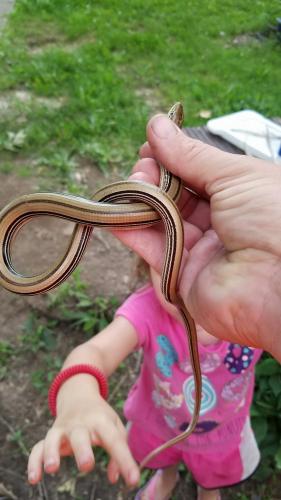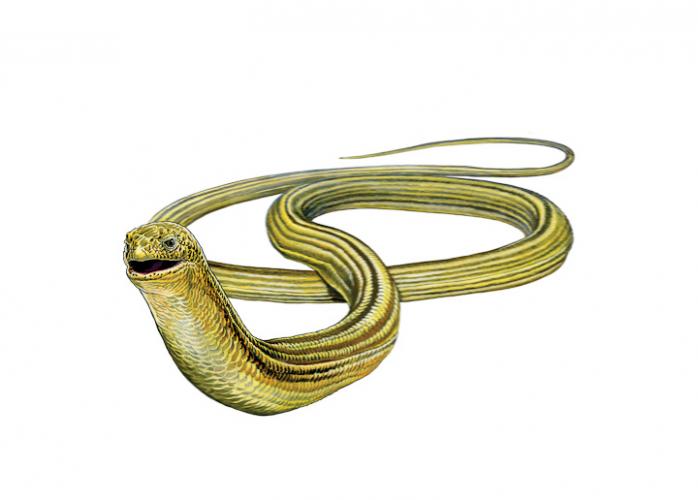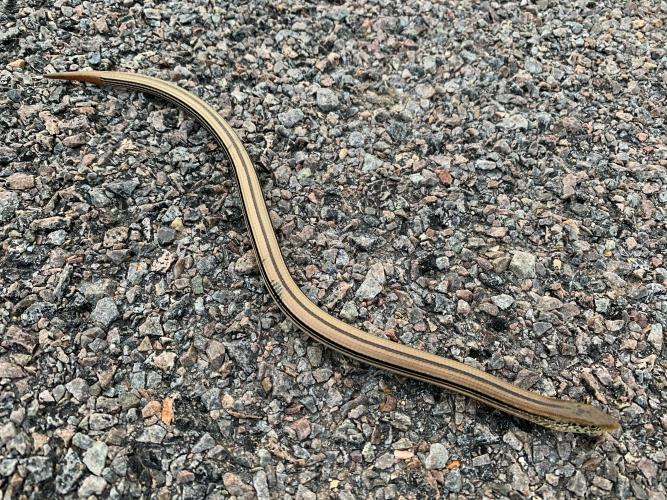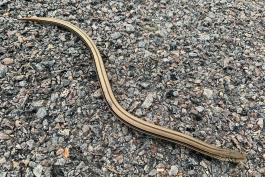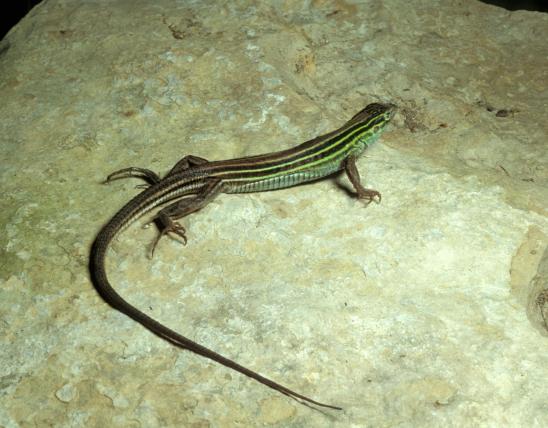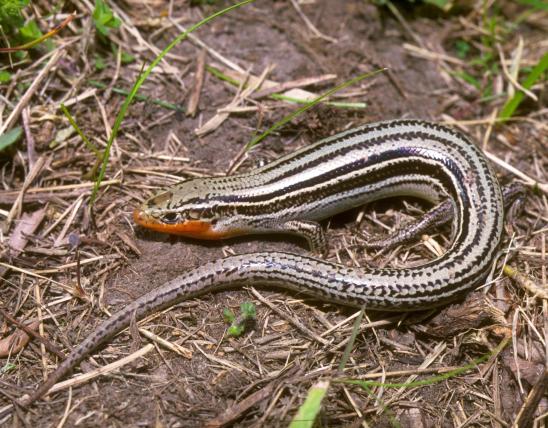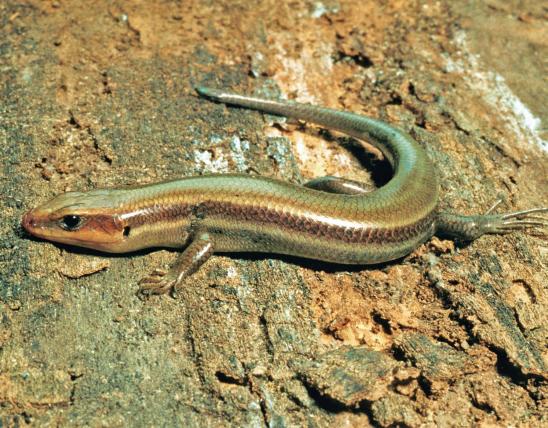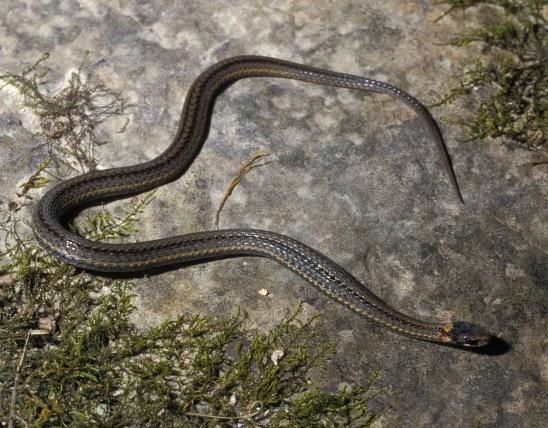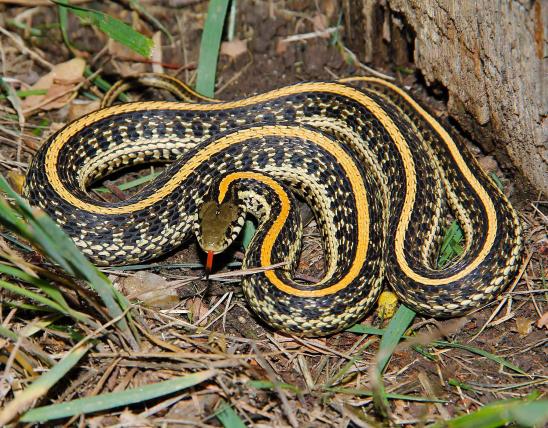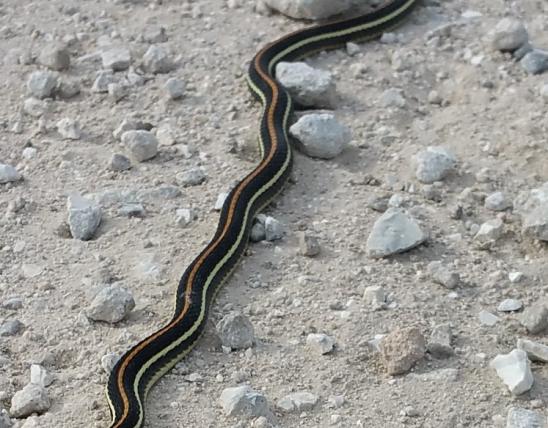The western slender glass lizard is a snakelike lizard that is long, slender, and legless. Its ground color is gray, tan, or brown, with black stripes on the back and sides. Narrow dark stripes located below the lateral (side) groove are prominent on juveniles and subadults but become faded once adulthood is reached. The stripe that runs along the back normally changes into a series of dark spots or crossbands as the lizard matures. The belly is white, and the underside of the tail normally has dark stripes.
Although glass lizards look like snakes and are sometimes called "glass snakes," there are quick ways to tell them from true snakes. The eyes are protected by movable eyelids; there is an ear opening on either side of the head; and a lateral (side) groove runs down the entire length of the body. Snakes have none of these characteristics. About two-thirds of the total length of this species is its long tail (unless the tail has been broken off and is being regenerated).
Similar species: Being legless, the western slender glass lizard is most likely to be confused with snakes, such as the lined snake, red-bellied snake, and gartersnakes, which can also be tan or brownish and have lengthwise stripes. Note the lizard's eyelids, ear openings, and lateral groove to help you distinguish it from snakes.
Adult total length: 22 to 46 inches. The western slender glass lizard is Missouri’s longest lizard.

Presumed statewide, except for the southeastern portions of the state. Most common in counties with former prairie and savanna habitat.
Habitat and Conservation
In Missouri, the western glass lizard occurs on prairies and pastures, in open woods, on dry, rocky hillsides, on glades, and in fens. They are most commonly found in the regions formerly dominated by prairie and grassland (northern and western Missouri). Farmers working grain fields sometimes plow up glass lizards. Glass lizards are also seen on moist, vegetative fens in the Ozarks.
Western slender glass lizards are active on the surface mainly from April to October. Activity peaks in spring (April and May, coinciding with breeding) and in October.
Slender glass lizards are active during the day as long as air temperatures range from 50°F to 90°F. This lizard often hides in clumps of grass or small mammal burrows and also burrows into loose soil.
Because of its rapid movement and its coloration, which blends so well with the vegetation, a glass lizard sighted in tall grass can quickly escape. If captured, a glass lizard will frantically thrash about, and the tail can quickly detach from the body.
Food
Glass lizards consume a variety of insects and other invertebrates, including land snails and spiders; they also eat other lizards, frogs, small snakes, eggs of ground-nesting birds, and occasionally young mice.
Unlike snakes, glass lizards do not have flexible jaws that can open super-wide to accommodate large prey. Therefore, glass lizards are limited to relatively small prey items, no larger than their head.
Life Cycle
In Missouri, mating apparently occurs from late April into early June. The female produces one clutch of eggs per season, containing 5–17 eggs, between June and early July. She lays them in a rotten log, under a rock, or under some similar cover. The mother remains with them until they hatch. The young take 3–4 years to reach adulthood. In the wild, individuals may live for at least 9 years.
Human Connections
Often when we think about a creature’s importance to humans, we think of economic factors, but it is wise to remember that animals that enchant us, surprise us, and evoke our curiosity — such as this odd, elegant, snakelike lizard — hold an immense value that cannot be calculated in numbers.
There is no truth to the belief that this or any other lizard can rejoin itself once its tail is detached.
The genus name, Ophisaurus, joins two Greek root words: orphis, meaning "serpent," "snake," or "reptile," and saurus, for "lizard" or "reptile." The species name, attenuatus, is the Latin word for "tapered, narrow, drawn-out, attenuated." So the scientific name basically means "thin-tapering snake-lizard," which is pretty descriptive!
Ecosystem Connections
Like most lizards, this species preys on insects and other small animals and therefore helps maintain their numbers in a natural balance.
Glass lizards may be preyed upon by snakes, hawks, and badgers. When handled or struck by an object, the very long, fragile tail will break off, sometimes into a few pieces, which can continue to wiggle. This can distract a predator long enough for the lizard to make a speedy retreat through the grass.
Missouri has only this one species in the glass lizard family. But its family, the Anguidae, is a wide-ranging group of lizards with a great diversity of forms. A number of species are long, slender, and legless, causing them to be easily confused with snakes. There are other species that have a reduced number of toes or only 2 limbs; there also are some species that are more “typical” lizards with 4 normal limbs. The Anguidae family contains about 130 species representing 14 genera. Members of this family occur in North and Central America, Europe, Asia, and northern Africa. Four genera, with a total of 14 species, occur in the United States: Anniella, the legless lizards, with five species; Gerrhonotus, the Texas alligator lizards, with one species; Elgaria, the western alligator lizards, with four species; and Ophisaurus, the glass lizards, with four species (including ours).
